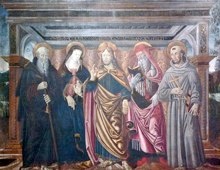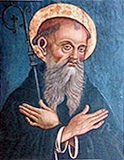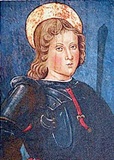Ludovico di Angelo was enrolled in the artists’ guild of Perugia in 1481. His only known signed work, which is dated 1489, is now in the Museo Capitolare (below). He was a member of the Workshop of 1496 (below). He held office in the artists’ guild on a number of occasions: as Prior in 1501, 1503 and 1518; and as Treasurer in 1510 and 1522.
Bernardino di Mariotto seems to have trained under him.
Workshop of 1496
An important document dated 1496 records that a group of artists formed a joint workshop in Perugia and took a year's lease on a workshop near the Porta Eburnea. These artist, some of whom had previously been associated with Perugino, were:
-
✴Eusebio da San Giorgio, who witnessed the contract (1495) commissioning Perugino to paint the San Pietro Altarpiece;
-
✴Berto di Giovanni, who collected a payment on behalf of Perugino in 1494 for the panel of the Pietà that was part of the Decemviri Altarpiece;
-
✴Ludovico di Angelo, who witnessed the final payment to Perugino for the San Pietro Polyptych in 1500; and
-
✴Lattanzio di Giovanni (died 1534), who had previously worked for Bartolomeo Caporali.
It is not known how long the formal association between these artists lasted, by they frequently worked together during the rest of their careers. They do not have seemed to have worked again with Perugino after 1495.
Perugia
Christ, the Virgin and saints (1489)

This panel, which is signed by Ludovico di Angelo and dated, is his only known signed work. It was first recorded in the late 18th century in the sacristy of the Oratorio di SS Simone e Fiorenzo, although there is nothing in its iconography to suggest that it was commissioned for this oratory. It moved to the Duomo in 1863 and is now in the Museo Capitolare.
The altarpiece depicts five standing figures in front of a rectangular tabernacle set in a landscape:
-
✴Christ blessing, at the centre;
-
✴the Virgin and St Antony Abbot to the left; and
-
✴SS Jerome and Francis to the right.
Madonna and Child with donor (1492)
The inscription at the base of this panel reveals that it was commissioned by a Benedictine nun, Giacoma di Baldo Perigli as an ex voto offering. It is sometimes attributed to Bernardino di Mariotto, but has more recently been attributed to his teacher, Ludovico di Angelo. It was transferred from San Francesco delle Donne to the Accademia di Belle Arti in 1810 and is now in the deposit of the Galleria Nazionale.
The panel depicts the Madonna and Child, with a nun kneeling to the left. She must be Sister Giacoma di Baldo Perigli, who was presumably a member of the community at San Francesco delle Donne.
SS Benedict and Rufinus (1492)


St Benedict St Rufinus of Amandola
These two small panels from San Pietro, which are now in the Galleria Tesori d’ Arte there, have recently been related to payments made by the monks of San Pietro in 1491-2 to Ludovico d’ Angelo.
Each panel is now in a gold-figured frame that probably dates to the 17th century. St Rufinus, who is depicted here as a young man in armour, is the saint whose relics are preserved in the crypt of the Benedictine Abbazia di San Rufino e Vitale at Amandola, Marche. Before the link with the documents mentioned above was made, this saint was often thought to be either St Michael or St George.
Madonna and Child with saints (1509)
This altarpiece from Sant’ Agostino, which is dated by inscription, seems to be the work that Bartolomeo di Lorenzo commissioned from Eusebio da San Giorgio in 1506 for his family chapel there. The contract specified that it should be similar to what is now known as the Tezi Altarpiece (1500) by Perugino, which was also in Sant’ Agostino).
It was also probably the work that was specified as being underway in Eusebio’s workshop in Perugia in the contract he signed in 1507 for the completion of the altarpiece by Pintoricchio in Sant’ Andrea, Spello: the contract allowed him to complete this existing commission but precluded him from leaving Spello for any other reason. The initials “LA SI” at the end of the inscription giving the date might indicate the involvement of two other members of the Workshop of 1496: Ludovico di Angelo and Sinibaldo Ibi.
The altarpiece, which depicts the Madonna and Child enthroned with SS Peter, Catherine of Alexandria, Agatha and Paul and two praying angels above, is now in the Galleria Nazionale.
Return to Art in: Perugia.



